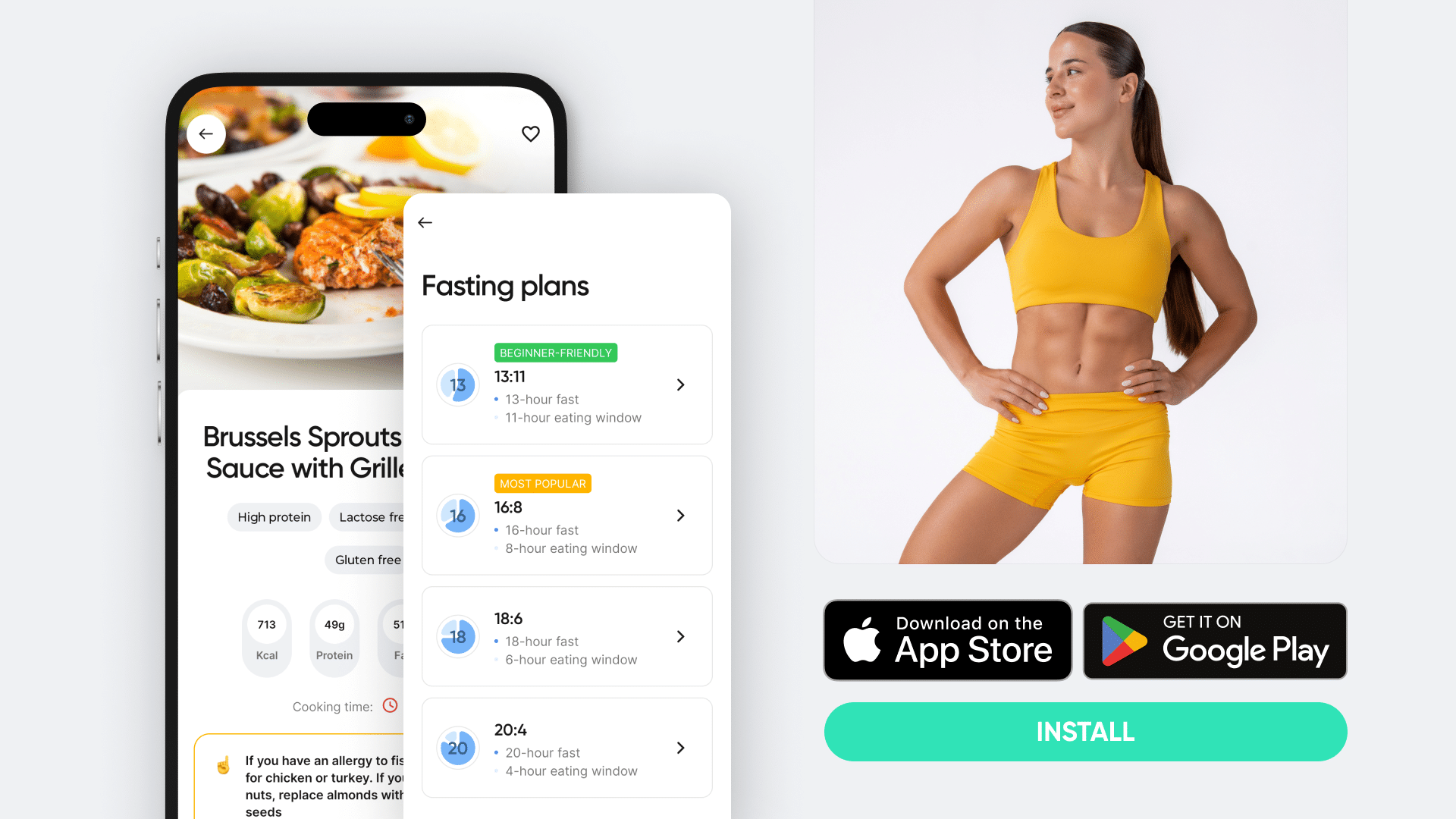Carb cycling is a dietary approach where you alternate between high and low carbohydrate intake on different days. It’s designed to optimize your body’s metabolic needs while also ensuring that you can still enjoy your favorite foods. This way of eating can potentially improve your physical performance, support weight loss, and enhance overall health (8).
Intermittent Fasting (IF), on the other hand, is a pattern of eating that toggles between periods of fasting and eating (2); it’s less of a diet in the traditional sense and more of a lifestyle choice aimed at improving health and wellness.
Given the unique possible benefits of these two dietary strategies, you may wonder if they can be combined for even greater effects. You should always talk to your healthcare provider before trying either or both strategies, especially if you have any medical conditions or are taking any medications.
Here’s what you need to know about incorporating carb cycling with intermittent fasting into your routine.
How Does Carb Cycling Work?
Carb cycling is all about varying your carb intake day to day. Here’s how it goes:
High-Carb Days
These are the days you load up on carbs. It’s like a party for your taste buds! These days usually coincide with your most intense workout days. Why? Because carbs are your body’s primary source of energy, and you need that extra fuel for your tough workouts.
Low-Carb Days
On these days, you dial down your carb intake. This doesn’t mean you ditch carbs altogether, you just eat less of them. Usually, these days would align with your lighter workout days or rest days.
No-Carb Days
There are days when you consume almost no carbs at all. Sounds tough, right? But remember, it’s only for a day and it’s not frequent. These days are usually your rest days; no intense workouts, no need for extra carbs.
BetterMe App helps you achieve your body goals with ease and efficiency by helping to choose proper meal plans and effective workouts. Start using our app and you will see good results in a short time.
How Does Intermittent Fasting Work?
Intermittent fasting involves alternating between periods of eating and fasting (2). The most common method is time-restricted feeding, where you have an eating window of 8-10 hours and fast for the remaining 14-16 hours of the day.
The most popular approach is the 16/8 method, where you fast for 16 hours and eat during an 8-hour window. During your fast you are only allowed to consume water, tea or coffee (without cream or sugar).
Other fasting methods include the 5:2 fast, where you eat normally for five days and restrict your calorie intake to 500-600 calories on two non-consecutive days. There’s also alternate-day fasting, where you alternate between one day of eating and one day of fasting.
Can You Do Intermittent Fasting and Carb Cycling At the Same Time?
Yes, you can. Doing carb cycling while intermittent fasting can potentially lead to the following benefits:
Improved Fat Burning
By cycling between high-carb and low-carb days and incorporating fasting, your body may become more efficient at burning fat for fuel.
Better Insulin Sensitivity
Both intermittent fasting and carb cycling have been shown to improve insulin sensitivity, which is important for regulating blood sugar levels and preventing chronic diseases (3) (7).
Enhanced Athletic Performance
Carb cycling can provide your body with the necessary energy for intense workouts, while intermittent fasting may improve recovery and reduce inflammation (6).
Increased Metabolic Flexibility
By regularly alternating between fasting and high-carb days, your body might become more adaptable to different fuel sources, leading to improved overall health.
Increased Flexibility and Sustainability
Combining both strategies allows for more flexibility in your diet, making it easier to stick to the long-term.
Read more: Keto Stuffed Jalapenos 4 Ways: Tasty, Spicy, and Surprisingly Low in Carbs
What Is The Best Schedule for Carb Cycling?
The best schedule for the carb cycling and intermittent fasting combination is the one that takes into account your workout schedule, lifestyle, and personal preferences. Here are some pointers to keep in mind when creating your carb cycling and IF schedule:
- Match high-carb days with intense workout days for optimal performance.
- Align low-carb days with lighter workout days or rest days.
- Plan your no-carb days on rest days so you don’t feel too depleted.
- Experiment with different schedules to find what works best for you.
Based on the tips above, here are a few options for scheduling your intermittent carb cycling with fasting:
Fast on Low-Carb Days
On low-carb days you can choose to fast for a specific amount of time, such as 16 hours. This means your first meal would be during the second half of the day, and you would consume all of your daily carbs in a shorter time frame.
Fast on No-Carb Days
You can also opt to fast on your no-carb days. As these days already have a lower calorie intake, fasting can amplify the fat-burning effects.
Alternate Fasting Days
Another way to incorporate IF with carb cycling is by alternating between fasting days and high-carb days. This allows you to cycle through different metabolic states.
Implementing a “Cheat Day”
Many people practicing carb cycling incorporate a “cheat day” into their routine, where they can indulge in their favorite high-carb foods. Similarly, with IF, you can choose to have a cheat day where you don’t follow your fasting schedule and consume more carbs than usual.
Fast Daily, and Maintain a Carb Cycling Schedule for Eating Window
Lastly, you can combine the two methods by fasting daily, but still following a carb cycling schedule for your eating window. This approach requires careful planning and monitoring of your macronutrient intake, but it can be effective in achieving weight loss goals.
If you wish to free yourself from all the extra pounds that have been weighting you down for way too long, start using the BetterMe app and overhaul your entire life!
Sample Intermittent Fasting Carb Cycling Meal Plan
Below is a 7-day carb cycling meal plan with intermittent fasting that you can use as a reference when creating your own schedule. It’s combined with daily 16/8 fasting and includes three high carb days, two low-carb days, and two no-carb days.
Day 1 (High Carb Day)
- Meal 1 (12 pm): Omelet with mixed vegetables and whole-wheat toast.
- Meal 2 (3 pm): Grilled chicken breast with brown rice and steamed broccoli.
- Meal 3 (6 pm): Whole-grain pasta with marinara sauce, lean beef, and mixed vegetables.
Day 2 (Low Carb Day)
- Meal 1 (12 pm): Avocado and turkey wrap with lettuce, tomato, and whole-wheat tortilla.
- Meal 2 (3 pm): Baked salmon with roasted asparagus.
- Meal 3 (6 pm): Grilled chicken breast with mixed vegetables and quinoa.
Day 3 (No Carb Day)
- Meal 1 (12 pm): Protein smoothie with almond milk, kale, banana, and protein powder.
- Meal 2 (3 pm): Grilled shrimp with zucchini noodles and marinara sauce.
- Meal 3 (6 pm): Baked chicken breast with steamed vegetables and a side salad.
Day 4 (High Carb Day)
- Meal 1 (12 pm): Greek yogurt with mixed berries and granola.
- Meal 2 (3 pm): Turkey sandwich on whole-wheat bread with avocado, lettuce, and tomato.
- Meal 3 (6 pm): Whole-grain bowl with chicken stir-fry with mixed vegetables.
Day 5 (Low Carb Day)
- Meal 1 (12 pm): Spinach and feta cheese omelet.
- Meal 2 (3 pm): Baked tilapia with roasted brussels sprouts.
- Meal 3 (6 pm): Lean ground turkey with sautéed mushrooms and green beans.
Day 6 (No Carb Day):
- Meal 1 (12 pm): Protein pancakes made with almond flour and topped with berries.
- Meal 2 (3 pm): Grilled chicken breast with steamed broccoli and a side salad.
- Meal 3 (6 pm): Baked salmon with roasted asparagus.
Day 7 (High Carb Day):
- Meal 1 (12 pm): Quinoa bowl with grilled chicken, mixed vegetables, and hummus.
- Meal 2 (3 pm): Whole-wheat turkey and cheese wrap with avocado, lettuce, and tomato.
- Meal 3 (6 pm): Whole-grain spaghetti with marinara sauce and lean ground beef.
Read more: 5 Chicken Alfredo Keto Recipes for Fast Dinners or Family Stunners Without Eating Too Many Carbs
Can You Lose Weight Fast With Carb Cycling?
You can lose weight with carb cycling, but how fast that happens comes down to a few factors. First and foremost, it depends on your individual body and metabolism. Some people may see results faster than others, while for others it may take longer to notice changes in their weight.
Additionally, the speed at which you lose weight with carb cycling also depends on how many overall calories you eat and how many you burn. Creating a calorie deficit is key to losing weight.
Another factor to consider is the type of carbohydrates you consume during your high-carb days. Eating healthy, complex carbs will provide sustained energy and satiety which can support weight loss, while consuming simple sugars and refined grains can lead to hunger and overeating (5).
In addition to diet, incorporating regular exercise into your routine can also help speed up weight loss with carb cycling. Physical activity not only burns calories, but it also helps build muscle and boost metabolism (4).
Combining carb cycling with intermittent fasting can also potentially speed up weight loss, as both methods have been shown to improve overall body composition and metabolic health.
[faq_block]
The Bottom Line
Carb cycling and intermittent fasting are two popular strategies that can be combined for even greater health benefits.
By alternating between high-carb and low-carb days while incorporating periods of fasting you might improve athletic performance, increase metabolic flexibility, and potentially achieve weight loss goals. That said, it may require some experimentation to determine what works best for your body and lifestyle. Remember to talk to your healthcare provider before starting a fasting or carb cycling regimen if you have any medical conditions or are taking any medications.
DISCLAIMER:
This article is intended for general informational purposes only and does not serve to address individual circumstances. It is not a substitute for professional advice or help and should not be relied on for making any kind of decision-making. Any action taken as a direct or indirect result of the information in this article is entirely at your own risk and is your sole responsibility.
BetterMe, its content staff, and its medical advisors accept no responsibility for inaccuracies, errors, misstatements, inconsistencies, or omissions and specifically disclaim any liability, loss or risk, personal, professional or otherwise, which may be incurred as a consequence, directly or indirectly, of the use and/or application of any content.
You should always seek the advice of your physician or other qualified health provider with any questions you may have regarding a medical condition or your specific situation. Never disregard professional medical advice or delay seeking it because of BetterMe content. If you suspect or think you may have a medical emergency, call your doctor.
SOURCES
- Effects of eight weeks of time-restricted feeding (16/8) on basal metabolism, maximal strength, body composition, inflammation, and cardiovascular risk factors in resistance-trained males (2019, .biomedcentral.com)
- Intermittent Fasting and Metabolic Health (2022, mdpi.com)
- Intermittent fasting: is there a role in the treatment of diabetes? A review of the literature and guide for primary care physicians (2021, iomedcentral.com)
- Physical Activity Plays an Important Role in Body Weight Regulation (2010, hindawi.com)
- The Burden of Carbohydrates in Health and Disease (2022, mdpi.com)
- The effect of fasting on indicators of muscle damage (2013, sciencedirect.com)
- The effect of intermittent energy and carbohydrate restriction v. daily energy restriction on weight loss and metabolic disease risk markers in overweight women (2013, cambridge.org)
- The Influence of Cyclical Ketogenic Reduction Diet vs. Nutritionally Balanced Reduction Diet on Body Composition, Strength, and Endurance Performance in Healthy Young Males: A Randomized Controlled Trial (2020, mdpi.com)











